The Effect of Meteorological Elements on Continuing Heavy Air Pollution: A Case Study in the Chengdu Area during the 2014 Spring Festival
Abstract
:1. Introduction
2. Materials and Methods
2.1. Data Source
2.2. Methods
3. Results and Discussion
3.1. Concentrations of Air Pollutants
3.2. Synoptic Circulation, Meteorological Conditions and Boundary Layer Structure during the Haze Event
3.2.1. Synoptic Circulation
3.2.2. Meteorological Conditions at the Surface
3.2.3. Atmospheric Boundary Layer
4. Conclusions
Acknowledgments
Author Contributions
Conflicts of Interest
Appendix A
| AQI | Air Pollution Level | Health Implications |
|---|---|---|
| 0–50 | Excellent | No health implications. |
| 51–100 | Good | Few hypersensitive individuals should reduce outdoor exercise. |
| 101–150 | Lightly Polluted | Slight irritations may occur, individuals with breathing or heart problems should reduce outdoor exercise. |
| 151–200 | Moderately Polluted | Slight irritations may occur, individuals with breathing or heart problems should reduce outdoor exercise. |
| 201–300 | Heavily Polluted | Healthy people will be noticeably affected. People with breathing or heart problems will experience reduced endurance in activities. These individuals and elders should remain indoors and restrict activities. |
| 300+ | Severely Polluted | Healthy people will experience reduced endurance in activities. There may be strong irritations and symptoms and may trigger other illnesses. Elders and the sick should remain indoors and avoid exercise. Healthy individuals should avoid outdoor activities. |
References
- Wu, D.; Wu, X.; Li, F.; Tan, H.; Chen, J.; Cao, Z.; Su, X.; Chen, H.; Li, H. Temporal and spatial variation of haze during 1951–2005 in Chinese mainland. Meteorol. Sin. 2010, 68, 680–688. [Google Scholar]
- Wang, Y.; Yao, L.; Wang, L.; Liu, Z.; Ji, D.; Tang, G.; Zhang, J.; Sun, Y.; Hu, B.; Xin, J. Mechanism for the formation of the January 2013 heavy haze pollution episode over central and eastern China. Sci. China 2014, 57, 14–25. [Google Scholar] [CrossRef]
- Ilten, N.; Selici, A.T. Investigating the impacts of some meteorological parameters on air pollution in Balikesir, Turkey. Environ. Monit. Assess. 2007, 140, 267–277. [Google Scholar] [CrossRef] [PubMed]
- Zhang, N.; Lu, Z.; Guan, Y.; Zhao, Y. Analysis of weather element characteristics and air pollution status during continuous fog days in Liaoning. Meteorol. Environ. Res. 2011, 2, 7–9. [Google Scholar]
- Chang, D.; Song, Y.; Liu, B. Visibility trends in six megacities in China 1973–2007. Atmos. Res. 2009, 94, 161–167. [Google Scholar] [CrossRef]
- Che, H.; Zhang, X.; Li, Y.; Zhou, Z.; Qu, J.J.; Hao, X. Haze trends over the capital cities of 31 provinces in China, 1981–2005. Theor. Appl. Climatol. 2008, 97, 235–242. [Google Scholar] [CrossRef]
- Aidaoui, L.; Triantafyllou, A.G.; Azzi, A.; Garas, S.K.; Matthaios, V.N. Elevated stacks’ pollutants’ dispersion and its contributions to photochemical smog formation in a heavily industrialized area. Air Qual. Atmos. Health 2015, 8, 213–227. [Google Scholar] [CrossRef]
- Gorai, A.K.; Tuluri, F.; Tchounwou, P.B.; Ambinakudige, S. Influence of local meteorology and NO2 conditions on ground-level ozone concentrations in the eastern part of Texas, USA. Air Qual. Atmos. Health 2015, 8, 81–96. [Google Scholar] [CrossRef] [PubMed]
- Górka-Kostrubiec, B.; Król, E.; Jeleńska, M. Dependence of air pollution on meteorological conditions based on magnetic susceptibility measurements: A case study from Warsaw. Stud. Geophys. Geod. 2012, 56, 861–877. [Google Scholar] [CrossRef]
- Shen, C.H.; Li, C.L. An analysis of the intrinsic cross-correlations between API and meteorological elements using DPCCA. Phys. A Stat. Mech. Appl. 2016, 446, 100–109. [Google Scholar] [CrossRef]
- Squizzato, S.; Masiol, M. Application of meteorology-based methods to determine local and external contributions to particulate matter pollution: A case study in Venice (Italy). Atmos. Environ. 2015, 119, 69–81. [Google Scholar] [CrossRef]
- Wang, B.; Cheng, Y.; Liu, H.; Chai, F. A typical production and elimination process of particles in Beijing during early 2008 Olympic Games. Meteorol. Environ. Res. 2011, 2, 70–73. [Google Scholar]
- Wang, F.; Yan, F. Analysis of the low visibility and air pollution process in shanghai during December 14–15, 2006. Meteorol. Environ. Res. 2010, 1, 61–65. [Google Scholar]
- Ding, J.; Zhu, T. Heterogeneous reactions on the surface of fine particles in the atmosphere. Chin. Sci. Bull. 2005, 48, 2267–2276. [Google Scholar] [CrossRef]
- Shi, K.; Liu, C.Q.; Li, S.C.; Shi, K.; Liu, C.Q.; Li, S.C. Self-organized criticality: Emergent complex behavior in PM10 pollution. Int. J. Atmos. Sci. 2013. [Google Scholar] [CrossRef]
- Zhang, Z.; Zhang, X.; Gong, D.; Kim, S.J.; Mao, R.; Zhao, X. Possible influence of atmospheric circulations on winter haze pollution in the Beijing-Tianjin-Hebei region, northern China. Atmos. Chem. Phys. 2016, 16, 561–571. [Google Scholar] [CrossRef]
- Wu, S. Analysis of weather conditions for air pollution in Nanning with high index. J. Guangxi Meteorol. 2004, 25, 40–43. [Google Scholar]
- Ordónez, C.; Mathis, H.; Furger, M.; Henne, S. Changes of daily surface ozone maxima in Switzerland in all seasons from 1992 to 2002 and discussion of summer 2003. Atmos. Chem. Phys. Discuss. 2005, 5, 1187–1203. [Google Scholar] [CrossRef]
- Jacob, D.J.; Winner, D.A. Effect of climate change on air quality. Atmos. Environ. 2009, 43, 51–63. [Google Scholar] [CrossRef]
- Wei, P.; Ren, Z.; Su, F.; Cheng, S.; Zhang, P.; Gao, Q. Environmental process and convergence belt of atmospheric NO2 pollution in north China. Acta Meteorol. Sin. 2011, 25, 797–811. [Google Scholar] [CrossRef]
- Ulas, I.; Tayanç, M.; Yenigün, O. Analysis of major photochemical pollutants with meteorological factors for high ozone days in Istanbul, Turkey. Water Air Soil Pollut. 2006, 175, 335–359. [Google Scholar]
- Jones, A.M.; Harrison, R.M.; Baker, J. The wind speed dependence of the concentrations of airborne particulate matter and NOX. Atmos. Environ. 2010, 44, 1682–1690. [Google Scholar] [CrossRef]
- Lin, W.; Xu, X.; Zhang, X.; Tang, J. Contributions of pollutants from north China plain to surface ozone at the Shangdianzi GAW station. Atmos. Chem. Phys. 2008, 8, 5889–5898. [Google Scholar] [CrossRef]
- Korsog, P.E.; Wolff, G.T. An examination of tropospheric ozone trends in the northeaster 25 US (1973–1983) using a robust statistical method. Atmos. Environ. 1991, 25B, 47–57. [Google Scholar] [CrossRef]
- Greene, J.S.; Kalkstein, L.S.; Ye, H.; Smoyer, K. Relationships between synoptic climatology and atmospheric pollution at 4 US cities. Theor. Appl. Climatol. 1999, 62, 163–174. [Google Scholar] [CrossRef]
- Liu, C.-M.; Huang, C.-Y.; Shieh, S.-L.; Wu, C.-C. Important meteorological parameters for ozone episodes experienced in the Taipei basin. Atmos.Environ. 1994, 28, 159–173. [Google Scholar] [CrossRef]
- Xu, W.Y.; Zhao, C.S.; Ran, L.; Deng, Z.Z.; Liu, P.F.; Ma, N.; Lin, W.L.; Xu, X.B.; Yan, P.; He, X.; et al. Characteristics of pollutants and their correlation to meteorological conditions at a suburban site in the north China plain. Atmos. Chem. Phys. Discuss. 2011, 11, 4353–4369. [Google Scholar] [CrossRef]
- Xu, X.; Li, Q.; Zhang, X. Analysis of the weather conditions for a case of heavy pollution in Beijing. Meteorol. Mon. 2005, 33, 32–36. [Google Scholar]
- Rao, X.; Li, F.; Zhou, N.; Yang, K. Analysis of a large-scale haze over middle and eastern China. Meteorol. Mon. 2008, 34, 89–96. (In Chinese) [Google Scholar]
- Huang, Z. Analysis on heavy pollution weather and meteorology factor change in Urumchi city. Arid Environ. Monit. 2005, 19, 154–157. (In Chinese) [Google Scholar]
- Tang, G.; Zhang, J.; Zhu, X.; Song, T.; Münkel, C.; Hu, B.; Schäfer, K.; Liu, Z.; Zhang, J.; Wang, L.; et al. Mixing layer height and its implications for air pollution over Beijing, China. Atmos. Chem. Phys. 2016, 16, 2459–2475. [Google Scholar] [CrossRef]
- Chen, Y.; Luo, B.; Xie, S.-D. Characteristics of the long-range transport dust events in Chengdu, southwest China. Atmos. Environ. 2015, 122, 713–722. [Google Scholar] [CrossRef]
- Chen, Y.; Xie, S. Temporal and spatial visibility trends in the Sichuan basin, China, 1973 to 2010. Atmos. Res. 2012, 112, 25–34. [Google Scholar] [CrossRef]
- Qian, Y.; Giorgi, F. Regional climatic effects of anthropogenic aerosols? The case of southwestern China. Geophys. Res. Lett. 2000, 27, 3521–3524. [Google Scholar] [CrossRef]
- Nozaki, K.Y. Mixing Depth Model Using Hourly Surface Observations; Report 7053; USAF Environmental Technical Application Center: Scott AFB, IL, USA, 1973. [Google Scholar]
- Cheng, Y.; Zheng, G.; Wei, C.; Mu, Q.; Zheng, B.; Wang, Z.; Gao, M.; Zhang, Q.; He, K.; Carmichael, G.; et al. Reactive nitrogen chemistry in aerosol water as a source of sulfate during haze events in China. Sci. Adv. 2017, 2, 1–11. [Google Scholar] [CrossRef] [PubMed]
- Wang, G.; Zhang, R.; Gomez, M.E.; Yang, L.; Zamora, M.L.; Hu, M.; Lin, Y.; Peng, J.; Guo, S.; Meng, J.; et al. Persistent sulfate formation from London fog to Chinese haze. Proc. Natl. Acad. Sci. USA 2016, 113, 13630–13635. [Google Scholar] [CrossRef] [PubMed]
- Cheng, C.S.; Campbell, M.; Li, Q.; Li, G.; Auld, H.; Day, N.; Pengelly, D.; Gingrich, S.; Yap, D. A synoptic climatological approach to assess climatic impact on air quality in south-central Canada. Part II: Future estimates. Water Air Soil Pollut. 2006, 182, 117–130. [Google Scholar] [CrossRef]
- Cuhadaroglu, B.; Demirci, E. Influence of some meteorological factors on air pollution in Trabzon city. Energy Build. 1997, 25, 179–184. [Google Scholar] [CrossRef]
- Tasdemir, Y.; Cindoruk, S.S.; Esen, F. Monitoring of criteria air pollutants in Bursa, Turkey. Environ. Monit. Assess. 2005, 110, 227–241. [Google Scholar] [CrossRef] [PubMed]
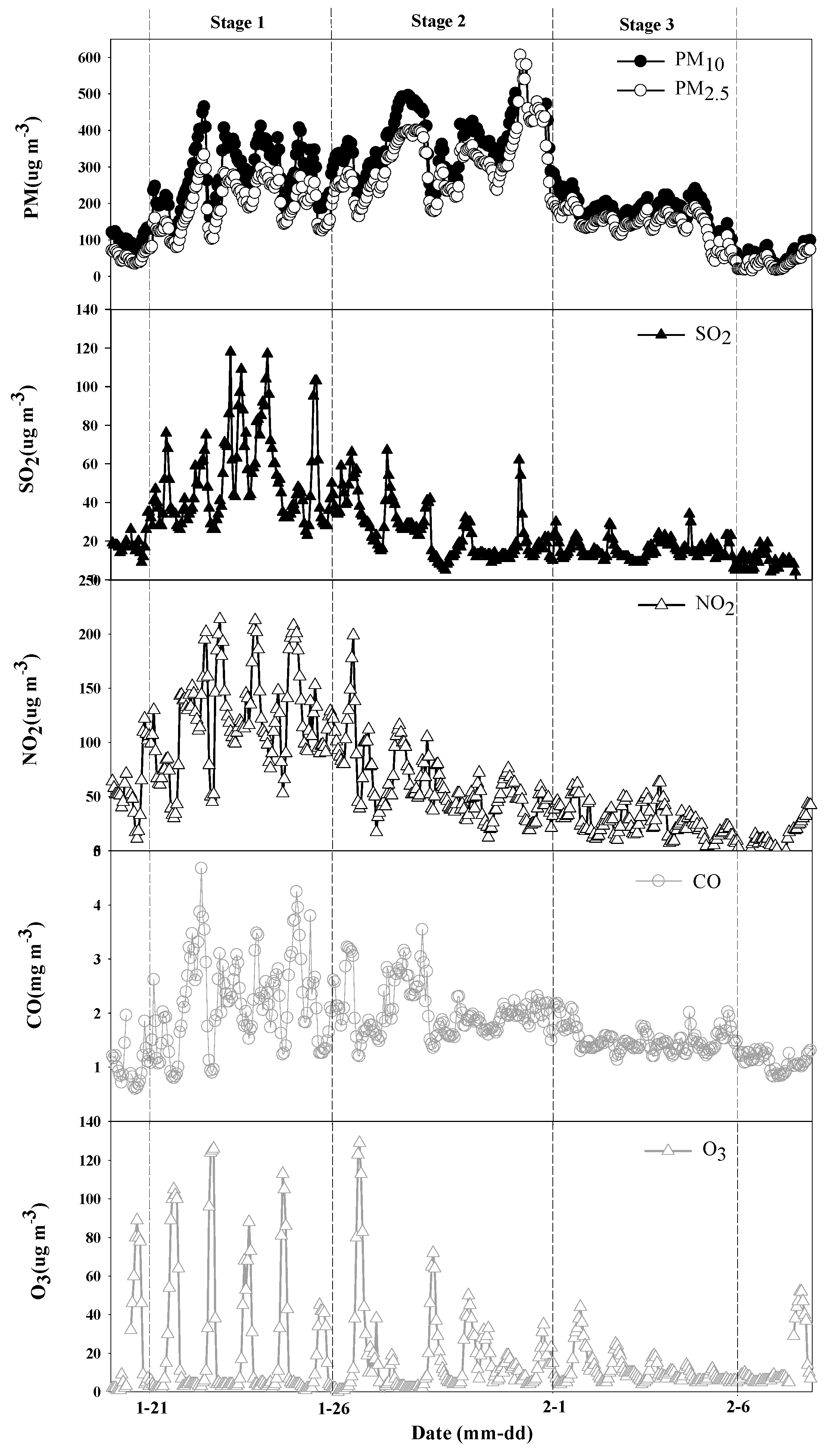
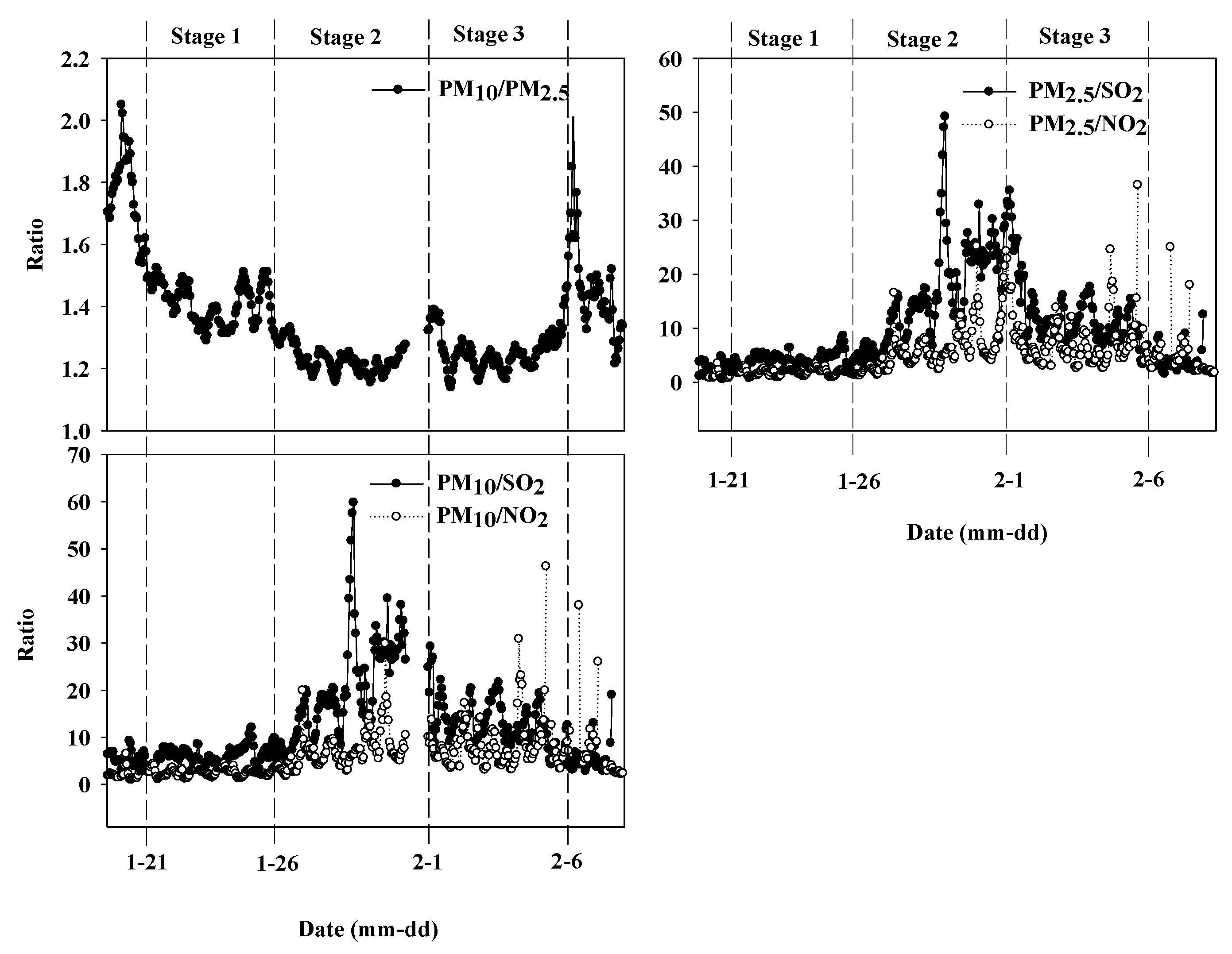
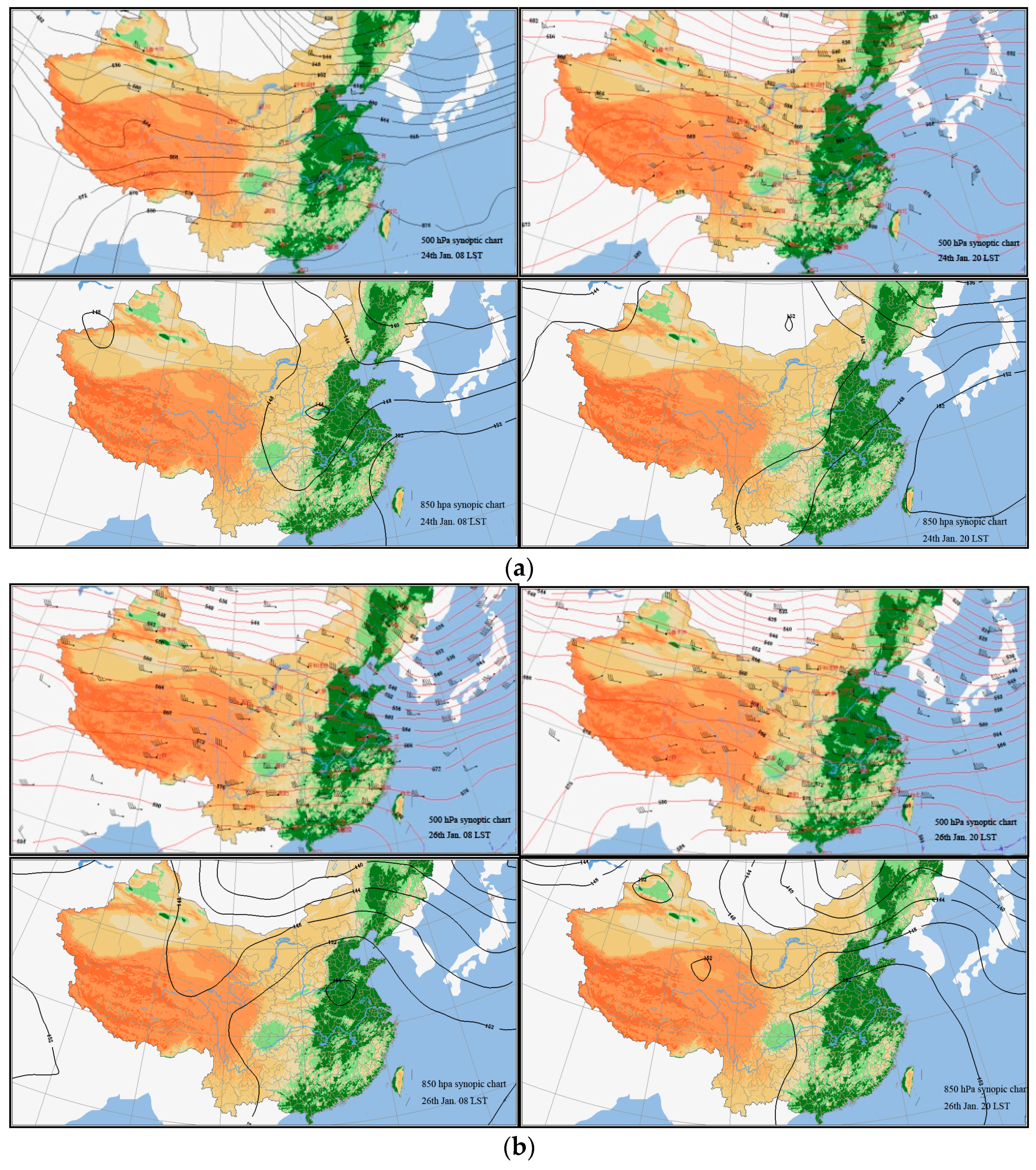
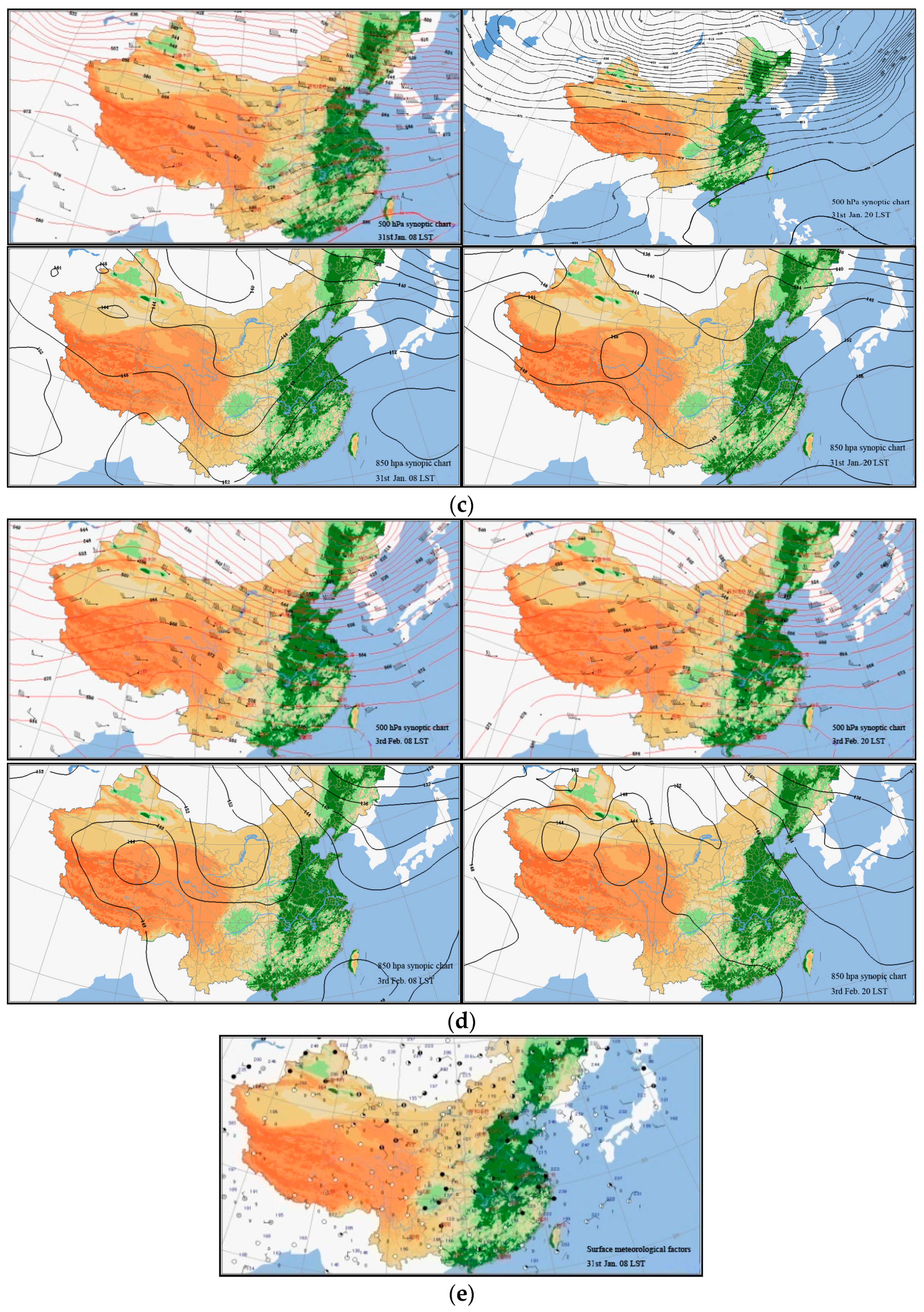
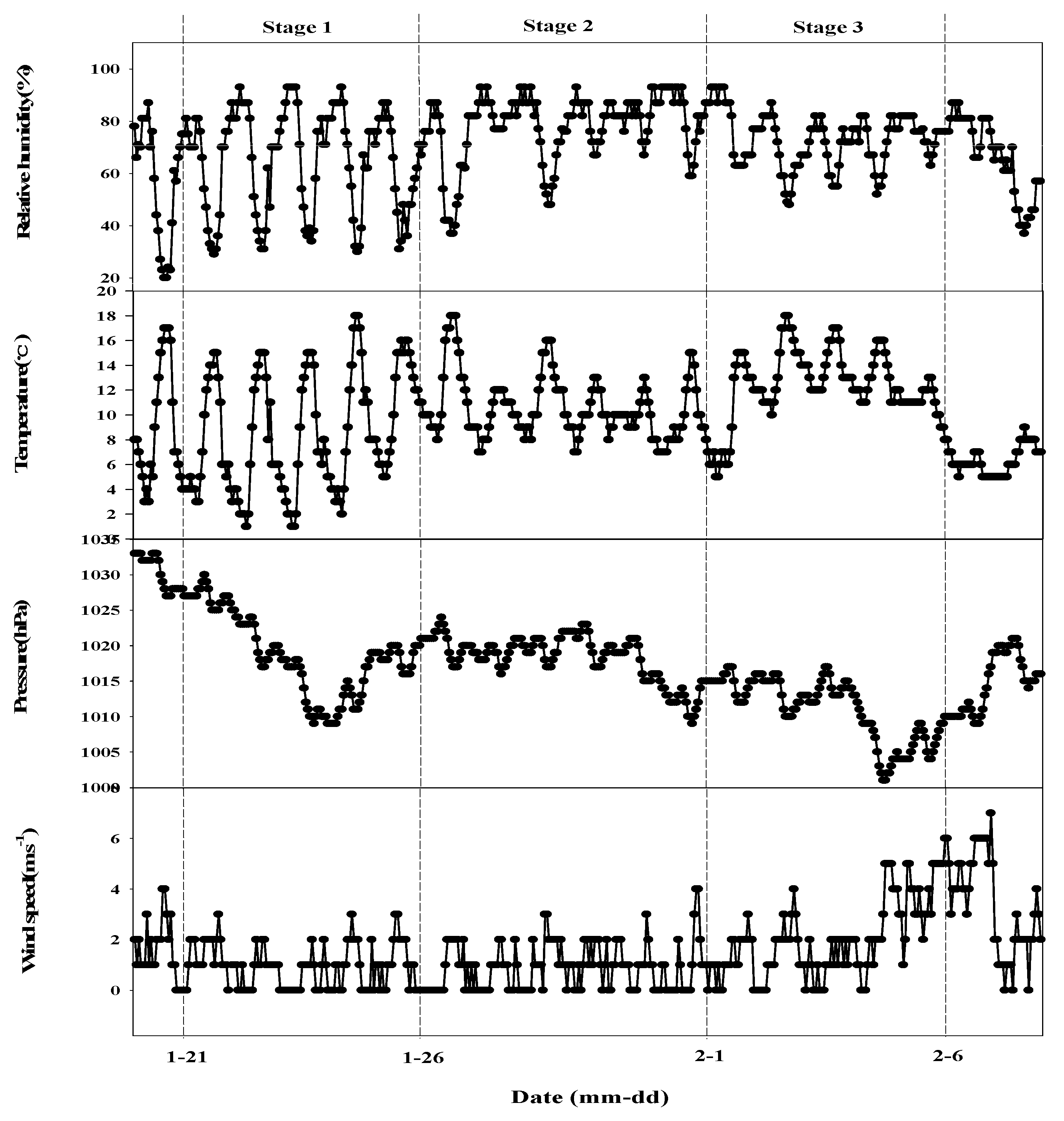
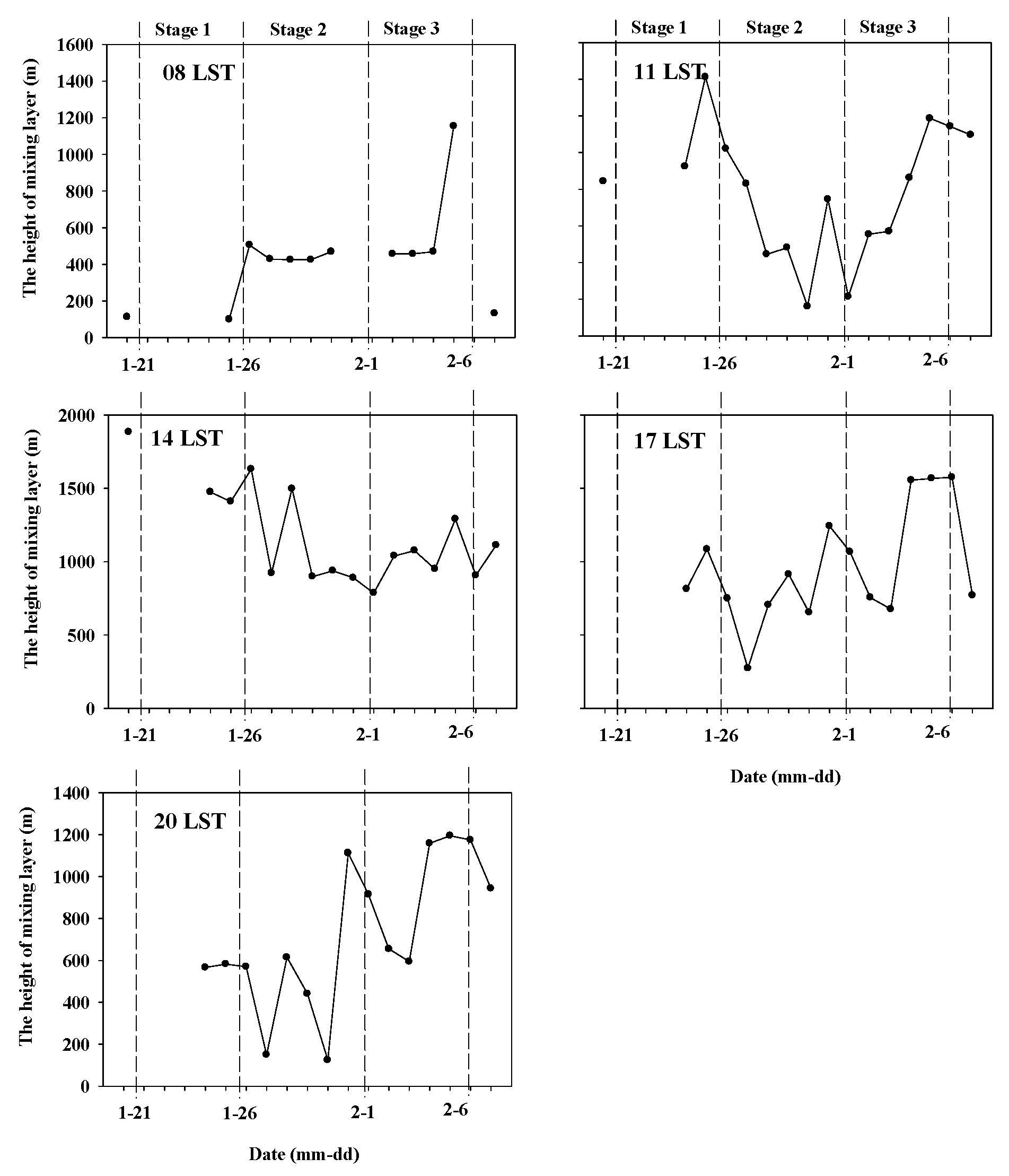
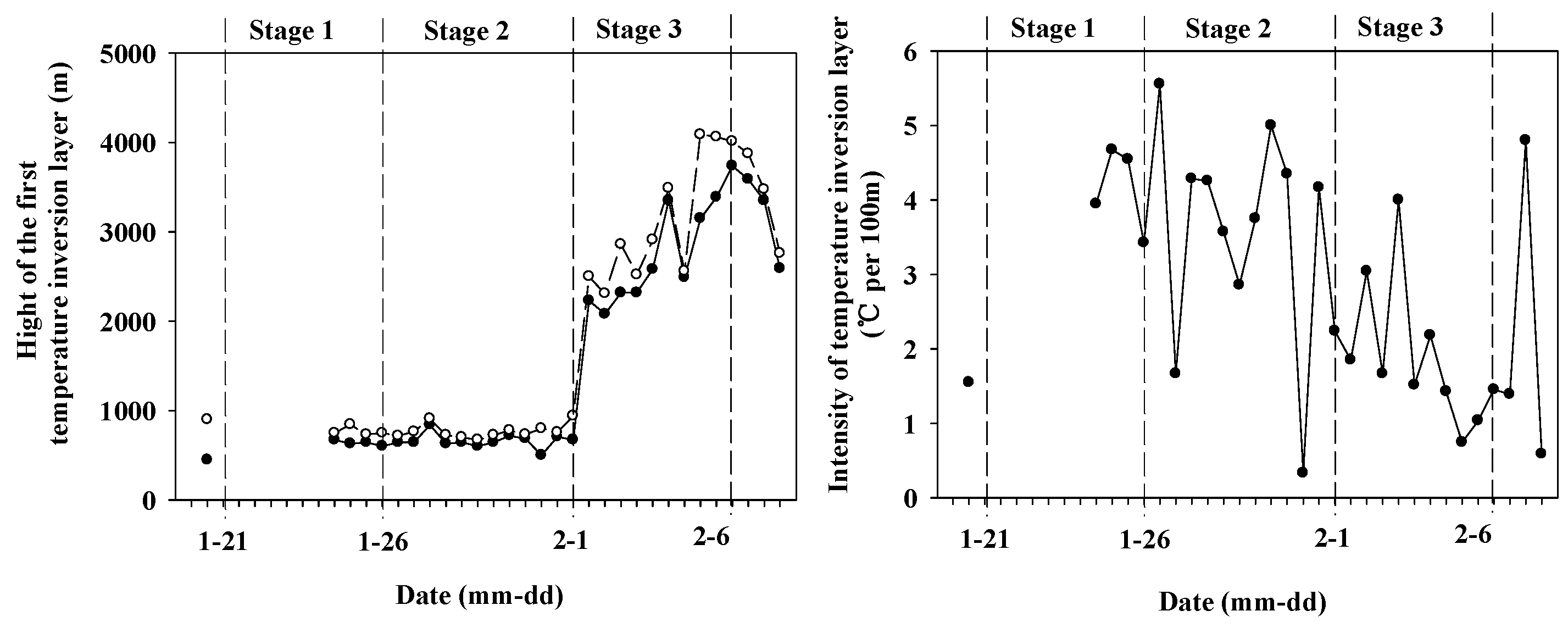

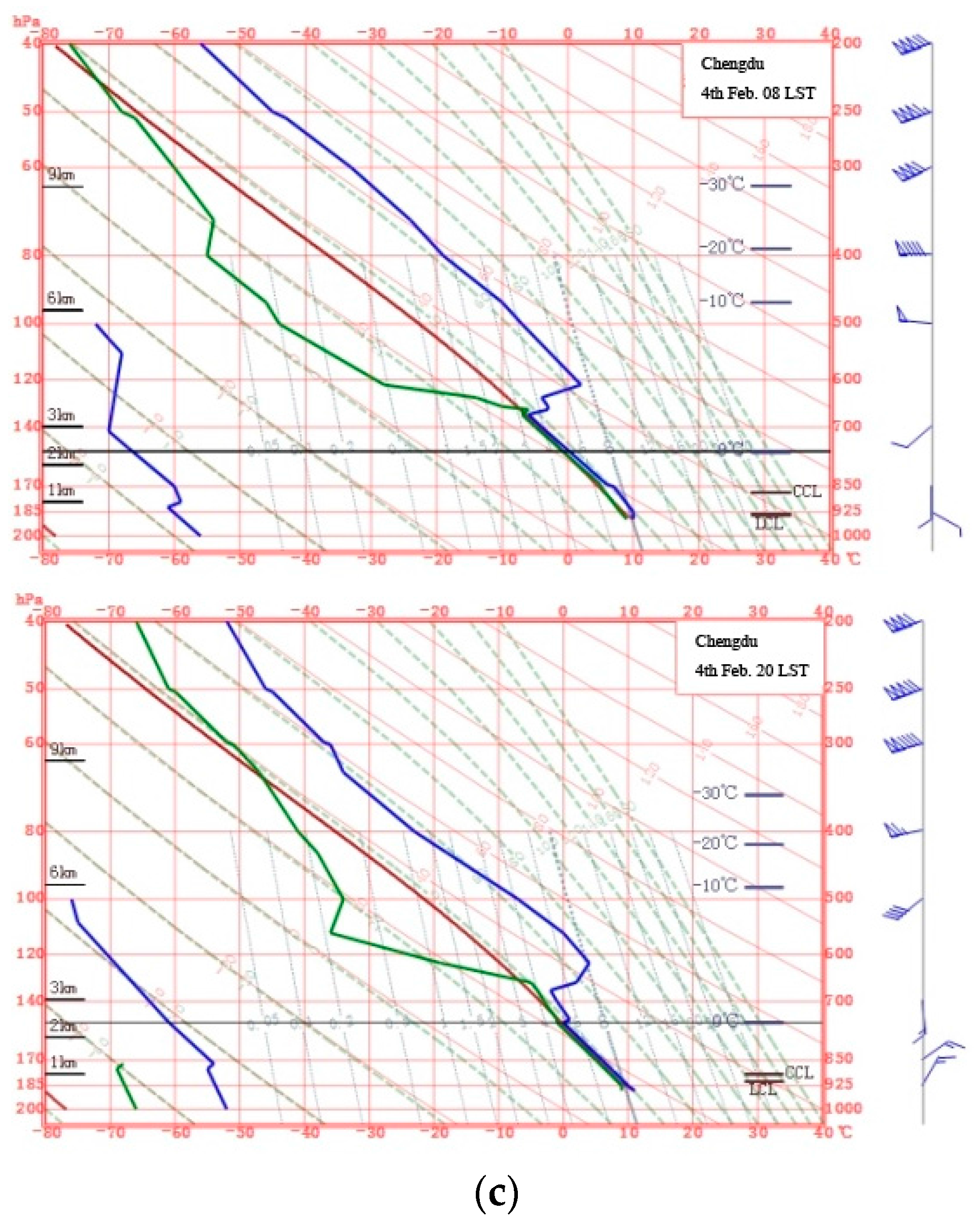
| Date | SO2 | NO2 | PM10 | CO | O3 | PM2.5 | AQI | Air Pollution Level | Primary Pollutant |
|---|---|---|---|---|---|---|---|---|---|
| 1/20 | 19 | 74 | 111 | 1.2 | 63 | 62 | 93 | Good | NO2 |
| 1/21 | 39 | 93 | 198 | 1.4 | 86 | 125 | 165 | Moderate pollution | PM2.5 |
| 1/22 | 41 | 129 | 302 | 2.0 | 69 | 206 | 256 | Heavy pollution | PM2.5 |
| 1/23 | 63 | 132 | 356 | 2.4 | 66 | 254 | 304 | Severe pollution | PM2.5 |
| 1/24 | 49 | 124 | 325 | 2.1 | 65 | 236 | 286 | Heavy pollution | PM2.5 |
| 1/25 | 44 | 120 | 307 | 2.2 | 40 | 217 | 267 | Heavy pollution | PM2.5 |
| 1/26 | 38 | 104 | 306 | 2.0 | 83 | 233 | 283 | Heavy pollution | PM2.5 |
| 1/27 | 26 | 77 | 387 | 2.1 | 24 | 313 | 363 | Severe pollution | PM2.5 |
| 1/28 | 24 | 76 | 399 | 2.3 | 60 | 330 | 380 | Severe pollution | PM2.5 |
| 1/29 | 17 | 57 | 356 | 1.9 | 53 | 297 | 347 | Severe pollution | PM2.5 |
| 1/30 | 13 | 57 | 384 | 1.9 | 34 | 310 | 360 | Severe pollution | PM2.5 |
| 1/31 | 20 | 47 | 570 | 2.0 | 36 | 427 | 470 | Severe pollution | PM10 |
| 2/1 | 15 | 54 | 217 | 1.8 | 69 | 166 | 216 | Heavy pollution | PM2.5 |
| 2/2 | 17 | 43 | 179 | 1.5 | 75 | 146 | 195 | Moderate pollution | PM2.5 |
| 2/3 | 17 | 49 | 186 | 1.5 | 65 | 153 | 203 | Heavy pollution | PM2.5 |
| 2/4 | 21 | 39 | 205 | 1.6 | 54 | 168 | 218 | Heavy pollution | PM2.5 |
| 2/5 | 16 | 26 | 98 | 1.6 | 43 | 78 | 105 | Light pollution | PM2.5 |
| 2/6 | 11 | 25 | 43 | 1.2 | 34 | 28 | 43 | Excellent | - |
| 2/7 | 18 | 34 | 64 | 1.1 | 50 | 45 | 63 | Good | PM2.5 |
| Pollutant | T | P | RH | WS | SD | Tr | Pr | RHr |
|---|---|---|---|---|---|---|---|---|
| PM2.5 | 0.005 | −0.008 | 0.41 ** | −0.47 ** | 0.13 | 0.17 | 0.03 | 0.16 |
| PM10 | −0.04 | 0.13 ** | 0.37 ** | −0.51 ** | 0.10 | 0.32 | 0.01 | 0.32 |
| SO2 | −0.11 * | 0.11 * | −0.06 | −0.27 ** | 0.65 ** | 0.78 ** | 0.25 | 0.63 ** |
| NO2 | −0.14 ** | 0.32 ** | −0.09 | −0.42 ** | 0.68 ** | 0.84 ** | 0.19 | 0.74 ** |
| CO | −0.22 ** | 0.10 * | 0.36 ** | −0.38 ** | −0.16 | 0.05 | 0.01 | 0.01 |
| O3 | 0.53 ** | 0.04 | −0.73 ** | 0.11 * | −0.16 | 0.02 | 0.03 | 0.06 |
© 2017 by the authors. Licensee MDPI, Basel, Switzerland. This article is an open access article distributed under the terms and conditions of the Creative Commons Attribution (CC BY) license (http://creativecommons.org/licenses/by/4.0/).
Share and Cite
Zeng, S.; Zhang, Y. The Effect of Meteorological Elements on Continuing Heavy Air Pollution: A Case Study in the Chengdu Area during the 2014 Spring Festival. Atmosphere 2017, 8, 71. https://doi.org/10.3390/atmos8040071
Zeng S, Zhang Y. The Effect of Meteorological Elements on Continuing Heavy Air Pollution: A Case Study in the Chengdu Area during the 2014 Spring Festival. Atmosphere. 2017; 8(4):71. https://doi.org/10.3390/atmos8040071
Chicago/Turabian StyleZeng, Shenglan, and Yu Zhang. 2017. "The Effect of Meteorological Elements on Continuing Heavy Air Pollution: A Case Study in the Chengdu Area during the 2014 Spring Festival" Atmosphere 8, no. 4: 71. https://doi.org/10.3390/atmos8040071





